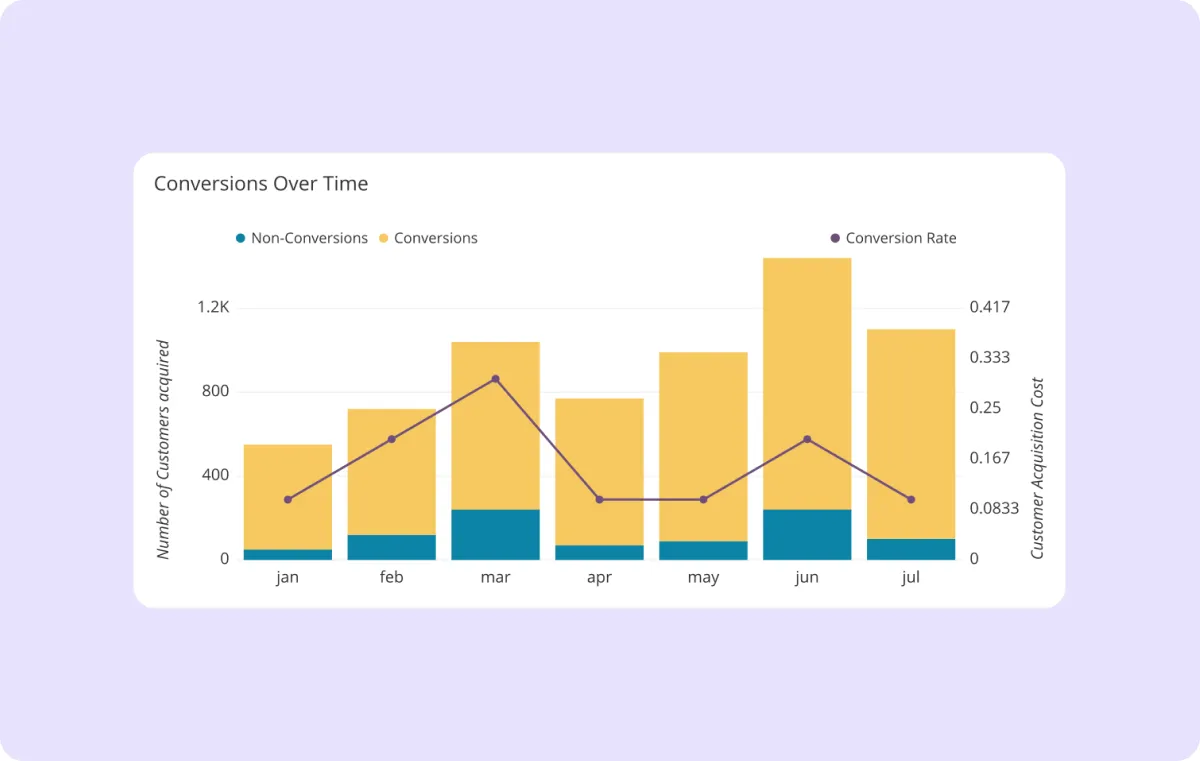Creating high-quality content is just the first step in an effective strategy — optimizing performance is what drives real results. Content marketing metrics offer an overview of what’s working and what’s not. They’re essential for refining your content strategy for future campaigns and ensuring your efforts translate into meaningful business outcomes.
Discover which content performance metrics to track and how to use them to maximize success.
What Are Content Marketing Metrics?
Content marketing metrics are measurements that help you understand the effectiveness of your digital marketing activity. They can be either quantitative, such as conversion rates and visitor counts, or qualitative, like brand awareness and customer satisfaction.
By establishing clear key performance indicators, you’ll learn which efforts are getting you closer to your goals and which are falling short. These insights let you make informed decisions about where to invest your time and budget. Without reliable content marketing analytics, it’s much harder to optimize campaigns, demonstrate return on investment (ROI), or align content marketing with broader business objectives.
How To Decide Which Content Metrics To Track
Your content marketing success starts with understanding your long-term goals. You might be aiming to increase brand awareness, generate leads, or drive conversions. Each of these goals requires tracking different types of metrics. Without clear objectives, it’s easy to focus on vanity metrics that look good on paper but don’t contribute to business growth.
To get started, assess your current content inventory. This includes published assets across your website, blog, email campaigns, and social channels. Take stock of what exists and where there are gaps or overlaps — leveraging tools like Captions can help you fill any underdeveloped areas or untapped segments. Once you have an overview of your content landscape, you’ll be better equipped to identify specific metrics that will help you measure performance.
16 Content Marketing Metrics That Help You Track Success
You can measure marketing success by monitoring engagement, traffic, conversions, and brand awareness. Here are the key metrics to track.
Traffic Metrics
Traffic metrics provide information about the number of people viewing your content and how they find it. Key metrics to track include:
- Impressions — The number of times your content appears in search results, whether or not anyone clicks on your links. Setting up an account with Google Search Console can help you access impressions data for your website.
- Visitors — The total number of visitors who have viewed your content, often by clicking a link in search results, accessing your site directly, or being referred by another user. This is one of the most fundamental data metrics that most people pay attention to, since more visitors means more potential customers.
- Page views — The number of times a particular page on your website has been viewed. Pay attention to which pages get the most traffic — this may give you an insight into customer needs.
- Bounce rate — The rate at which visitors to your site depart without viewing additional content. A high bounce rate indicates your audience is not engaging with your content.
- Landing pages — The pages users arrive at when visiting your site. Paying attention to landing pages tells you which content is performing well in search results.

Engagement Metrics
Drawing traffic to your site is only the first step. Once the traffic has arrived, your content needs to hold their attention. If engagement is low, consider working to improve your content or perhaps redefining your target audience. Consider tracking the following metrics:
- Time on page — The average time a visitor spends viewing content on your website. Higher time on page is an indication that users find your content valuable.
- Return rate — Users who have visited your site more than once, indicating higher engagement and loyalty.
- Social media engagement — The volume of likes, shares, and comments on your social media accounts. High engagement here can build stronger relationships with your customers and increase brand visibility.
- Comments — Feedback you receive on your website and social media. This is a qualitative rather than quantitative metric that will give you an idea of user sentiment.
Conversion Metrics
The next step after engagement is conversion of visitors into customers. Conversion metrics track the effectiveness of your calls to action, whether that’s encouraging viewers to sign up for an email list, purchase a product, or download a brochure. Metrics related to conversion include:
- Lead generation — The number of customer names and emails you amass, often via a subscriber or mailing list. Giving away a free resource or product trial is a good way to generate more leads.
- Sales — Revenue generated through your channels. For some business models, this is the ultimate end goal.
- Conversion rate — The percentage of visitors who complete a desired action, such as joining a mailing list or making a purchase.
- ROI — ROI is a percentage showing revenue earned against money spent. Customer acquisition cost is a similar metric, showing the amount of money you invest in your marketing efforts for each customer you gain.
Brand Awareness Metrics
Sometimes the goal of your content marketing efforts is to raise awareness of your brand, which can lead to revenue further down the funnel. The main metrics to track are:
- Brand mentions — The number of times users named your brand in comments on social media.
- Backlinks — Links from other sites to your content. These can increase traffic to your site and search rankings. Google tracks backlinks as part of its formula for determining where to place your content in its search engine results pages.
- Traffic sources — Knowing where your content is coming from, whether it’s social media, search, or email, helps you determine where to focus your content marketing efforts. Both Google Search Console and Google Analytics provide traffic source data.
How To Track Metrics Effectively
Implementing the following best practices will ensure you use metrics to boost content marketing effectiveness:
Conduct Monthly Data Reviews
Regular performance reviews are a crucial part of an overall marketing plan, helping you spot trends and make evidence-based adjustments. To avoid becoming overwhelmed, focus on the metrics that are most important to the current stage of your business. If you’re just starting out, traffic numbers, traffic sources, and content engagement might be most helpful. If you already have plenty of traffic, focus on engagement and conversion metrics.
Use Reliable Tools and Dashboards
Google Analytics and Google Search Console are powerful, free tools for tracking metrics that can be customized to your marketing needs. Other analytics tools range from simple and broad to complex and highly specialized, and they usually require a paid subscription. Pair these tools with content creation platforms like Captions, so you can produce and test more content across channels.
Report Results Clearly and Consistently
Set up your reporting tools to present information in accessible formats, using graphs and charts when available to aid understanding. Once reporting features are set up, you can run them repeatedly for a consistent picture of changes over time.
Calculate ROI
Calculating ROI is essential to understand the value of your content marketing efforts. It indicates whether your content is generating meaningful value relative to your spend. Start by tracking all related expenses — this could include freelancer fees, promotional tools, and distribution costs. Then, measure the revenue or value the content has generated, such as number of leads or sales revenue. This is the formula:
ROI = (revenue from content - cost of content) ÷ cost of content x 100
Take Action
Data will give you deeper insight into the strengths and weaknesses of your marketing ideas. After that, you can modify or eliminate your less successful content and allocate more resources to what’s yielding results.

Take Your Content Strategy to the Next Level With Captions
Once you’re tracking the right metrics, the next step is to create more effective and engaging content. It’s worth investing in a platform that makes creating high-quality video faster and easier.
Captions Marketing Video Maker is a powerful tool that simplifies the content creation process. It combines intuitive AI editing, subtitling, and eye-catching visuals. You can generate multiple high-quality marketing videos just by supplying a product link. Captions is the ultimate tool for creating polished, scroll-stopping videos.









